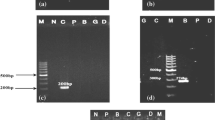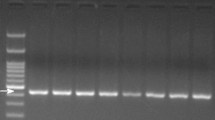Abstract
Detection of species fraud in meat products is important for consumer protection and food industries. A molecular technique such as PCR method for detection of beef, sheep, pork, chicken, donkey, and horse meats in food products was established. The purpose of this study was to identification of fraud and adulteration in industrial meat products by PCR-RFLP assay in Iran. In present study, 224 meat products include 68 sausages, 48 frankfurters, 55 hamburgers, 33 hams and 20 cold cut meats were collected from different companies and food markets in Iran. Genomic DNA was extracted and PCR was performed for gene amplification of meat species using specific oligonucleotid primers. Raw meat samples are served as the positive control. For differentiation between donkey’s and horse’s meat, the mitochondrial DNA segment (cytochrome-b gene) was amplified and products were digested with AluI restriction enzyme. Results showed that 6 of 68 fermented sausages (8.82%), 4 of 48 frankfurters (8.33%), 4 of 55 hamburgers (7.27%), 2 of 33 hams (6.6%), and 1 of 20 cold cut meat (5%) were found to contain Haram (unlawful or prohibited) meat. These results indicate that 7.58% of the total samples were not containing Halal (lawful or permitted) meat and have another meat. These findings showed that molecular methods such as PCR and PCR-RFLP are potentially reliable techniques for detection of meat type in meat products for Halal authentication.


Similar content being viewed by others
References
Abdel-Rahman SM, El-Saadani MA, Ashry KM, Haggag AS (2009) Detection of adulteration and identification of cat’s, dog’s, donkey’s and horse’s meat using species-specific PCR and PCR-RFLP techniques. Aust J Basic Appl Sci 3(3):1716–1719
Aida AA, Che Man YB, Wong CMVL, Raha AR, Son R (2005) Analysis of raw meats and fats of pigs using polymerase chain reaction for Halal authentication. Meat Sci 69:47–52
Ayaz Y, Ayaz ND, Erol I (2006) Detection of species in meat and meat products using enzyme-linked immunosorbent assay. J Muscle Foods 17:214–220
Chikuni K, Tabata T, Kosugiyama M, Monma M, Saito M (1994) Polymerase chain reaction assay for detection of sheep and goat meats. Meat Sci 37:337–345
Ferguson LR (2010) Meat and cancer. Meat Sci 84:308–313
Hopwood AJ, Fairbrother KS, Lockley AK, Bardsley RG (1999) An actin gene-related polymerase chain reaction (PCR) test for identification of chicken in meat mixtures. Meat Sci 53:227–231
Hsieh YHP, Woodward BB, Ho SH (1995) Detection of species substitution in raw and cooked meats using immunoassays. J Food Prot 58:555–559
Hsieh YHP, Johnson MA, Wetzstein CJ, Green NR (1996) Detection of species adulteration in pork products using agar gel immunodiffusion and enzyme linked immunosorbent assay. J Food Qual 19:1–9
Hsieh YHP, Chen FC, Sheu SC (1997) AAES research developing simple, inexpensive tests for meat products. Highlights Agric Res 44(2):19–20
Jain S, Brahmbhait MN, Rank DN, Joshi CG, Solank JV (2007) Use of cytochrome b gene variability in detecting meat species by multiplex PCR assay. Indian J Anim Sci 77(9):880–888
Luo J, Wang J, Bu D, Li D, Wang L, Wei H, Zhou L (2008) Development and application of a PCR approach for detection of beef, sheep, pig, and chicken derived materials in feedstuff. Agr Sci China 7(10):1260–1266
Meyer R, Candrian U, Luthy J (1994) Detection of pork in heated meat products by the polymerase chain reaction. J AOAC Int 77:617–622
Meyer R, Hofelein C, Luthy J, Candrian U (1995) Polymerase chain reaction-restriction fragment length polymorphism analysis: a simple method for species identification in food. J AOAC Int 78:1542–1551
Ong SB, Zuraini MI, Jurin WG, Cheah YK, Tunung R, Chai LC, Haryani Y, Ghazali FM, Son R (2007) Meat molecular detection: sensitivity of polymerase chain reaction-restriction fragment length polymorphism in species differentiation of meat from animal origin. ASEAN Food J 14(1):51–59
Partis L, Croan D, Guo Z, Clark R, Coldham T, Murby J (2000) Evaluation of a DNA fingerprinting method for determining the species origin of meats. Meat Sci 54:369–376
Saiki RK, Gelfand DH, Stoffel S, Scharf SJ, Higuchi R, Horn GT (1988) Primer-directed enzymatic amplification of DNA with a thermostable DNA polymerase. Science 239:487–491
Acknowledgements
The authors would like to thank all the staff of Biotechnology Research Center of Islamic Azad University of Shahrekord Branch in southwest Iran for their sincere support.
Author information
Authors and Affiliations
Corresponding author
Rights and permissions
About this article
Cite this article
Doosti, A., Ghasemi Dehkordi, P. & Rahimi, E. Molecular assay to fraud identification of meat products. J Food Sci Technol 51, 148–152 (2014). https://doi.org/10.1007/s13197-011-0456-3
Revised:
Accepted:
Published:
Issue Date:
DOI: https://doi.org/10.1007/s13197-011-0456-3




